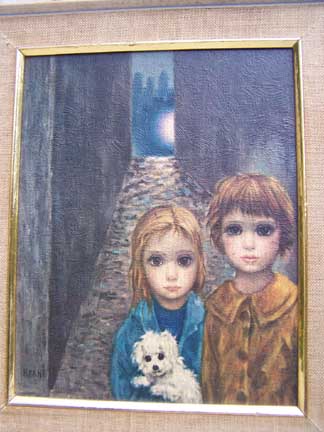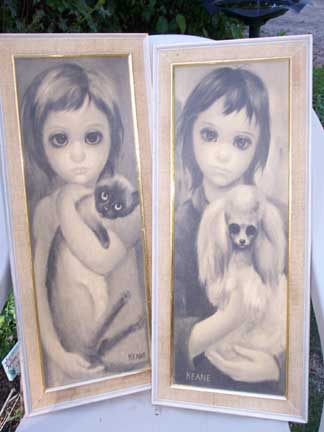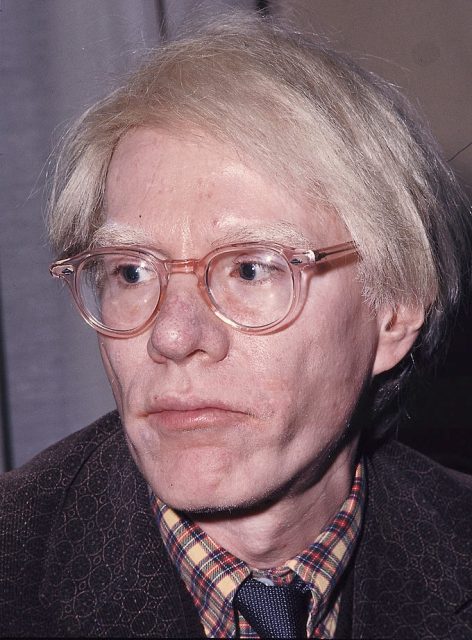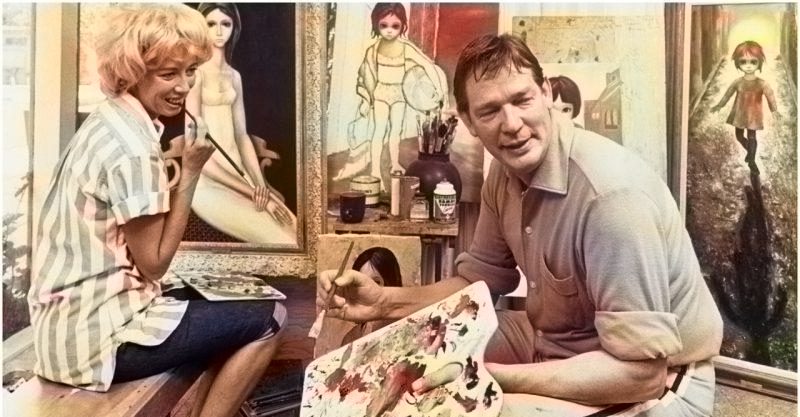Walter Keane emerged on the art scene during the 1960s with the immensely popular paintings known as “Big Eyes.” He went from being a real estate broker to one of the highest paid artists of his time, charging up to $50,000 for a painting. The story made public was that he painted the children he saw traveling in post-war Berlin.
Walter Keane liked to talk about himself. He bragged about his talent, self-publicizing himself, saying in an interview for Life magazine that “Nobody painted eyes like El Greco and nobody can paint eyes like Walter Keane.”
Keane may have fit the image of what was considered to be artistic or eccentric behavior, but in fact, it was his wife, Margaret Keane, who painted the pictures. The Keane fraud lasted over 20 years before Margaret revealed the truth on a radio show.
Walter Keane even wrote a book in 1983, The World of Keane, in which he says that, when he first met Margaret at an outdoor art fair in San Francisco, she told him that he was the “greatest” and “most handsome” artist she knew and that she paticularly loved his big-eyed paintings. They indeed met each other at an art fair in 1955, but Walter Keane was selling pictures of Parisian street scenes as his own, while it was Margaret who was developing the “Big Eyes.” They got married that same year, and it was after two years of marriage that Margaret discovered the Parisian scenes that Walter claimed to have painted during the time he studied art in Paris were someone else’s. Walter forged his signature on them, covering the artist’s name with paint.

When they met in 1955, Margaret had just divorced her first husband and moved to San Francisco with her daughter. Margaret began painting when she was a child and took a few art classes at the Watkins Art Institute in Nashville. She later attended the Traphagen School Of Design in New York City for a year. Before specializing in portraits, Margaret also experimented in Kitsch art, which can be recognized in her later paintings.
Walter, 17 years her senior, moved to Berkeley, California, in the 1940s with his first wife, Barbara. Both of them were real estate brokers until 1948, when they started traveling around Europe with their baby girl, staying first in Heidelberg and later in Paris. When they returned to the United States, the couple started teaching French to children through newly invented, hand-made, educational toys. Later, Barbara became head of the dress design department at the University of California in Berkeley, and Walter apparently dedicated himself to his painting. The two divorced in 1952.
In a much later interview, Margaret described herself as “very timid and shy,” therefore she preferred staying at home painting while Walter enjoyed going out selling their work. He first started selling Margaret’s paintings at his favorite club, The Hungry i, a popular beatnik place in San Francisco during the 1950s. It was there that Margaret caught Walter selling her paintings under his name.

And yet, he convinced her that it was for the greater good, that people already believed he was the painter and they liked talking to the artist. He said to Margaret that revealing the truth would jeopardize both of them. And of course, they needed the money the paintings earned. So Margaret remained in the shadows while Walter gained all the fame and glory for her paintings. Later, when asked in an interview for The Guardian why she went along with the fraud, Margaret said, “Back then, women kind of went along with their husbands, didn’t rock the boat.” He didn’t use just words to persuade her. Walter also threatened to kill Margaret if she told the truth to anyone.
“As if goaded by a kind of frantic despair, I sketched these dirty, ragged little victims of the war with their bruised, lacerated minds and bodies, their matted hair and runny noses. Here my life as a painter began in earnest,” said Walter during a TV interview, claiming that he portrayed the children in post-war Berlin. Margaret went along with the fraud, but she felt devastated. Those children were part of herself, an important one. She temporarily lost her hearing during a mastoid operation when she was a child and learned to follow people’s eyes to understand them.
“Big Eyes” became a hit in the early 1960s. Even Andy Warhol admired Keane, saying “I think what Keane has done is just terrific. It has to be good. If it were bad, so many people wouldn’t like it.” Many people liked it indeed.

Celebrities such as Dean Martin, Jerry Lewis, Joan Crawford, Kim Novak, and Natalie Wood were buying the originals while people who couldn’t afford them started buying posters and postcards with the paintings. The sad children with big eyes were immensely popular. They were exhibited in numerous shop window displays and had their section in the big supermarkets. Ultimately, Keane opened a gallery to sell “his” work.
The couple, along with Margaret’s daughter, moved to a mansion with a swimming pool and servants. Walter had affairs with other women, organizing parties at their home attended by the Beach Boys and other celebrities. Margaret saw none of this glamour because she locked herself in the studio painting 16 hours per day, providing the material for Walter.
Margaret tried promoting herself as an artist, painting portraits in a completely different style than the children with big eyes and, eventually, Walter admitted that his wife was also an artist. Although there were art critics who claimed that Margaret’s style was superior to Walter’s, she never gained much popularity for anything compared to “Big Eyes.”
John Canaday, an art critic for the New York Times, always criticized Keane’s work as kitsch. His harshest critique came after Walter’s (Margaret’s) painting that featured a hundred big-eyed children of many different nationalities, known as “Tomorrow Forever,” was hung in the Pavilion of Education at the 1964 World’s Fair in New York City. “This tasteless hack work contains about 100 children, and hence it is about 100 times as bad as the average Keane,” wrote Canaday, after which the World’s Fair decided to take it down.
Soon after, Margaret left Walter and moved to Honolulu, Hawai, with her daughter. In 1970, Margaret announced the truth about the famous paintings, but 16 years passed until she was officially ruled as the real artist in court. She sued Walter in 1986, a trial during which Walter represented and cross-examined himself. The trial was brought to an end when the judge decided to give both Margaret and Walter painting materials and an hour to paint a picture. Walter didn’t paint anything while Margaret managed to finish a picture of a big-eyed kid in 53 minutes. Although the jury awarded her $4 million in damages, Margaret said that she just wanted the truth revealed and to be recognized as the author of the paintings.
Walter Keane remarried and divorced once again, spending his last days penniless, bitter, and alone. Until his death in 2000, at the age of 85, he still claimed that he was the real painter of the “Big Eyes” paintings. Margaret, on the other hand, remarried in 1970 and found some peace in Honolulu. She also became a Jehovah’s Witness and later moved back to San Francisco where she lives today. She still paints every day.
